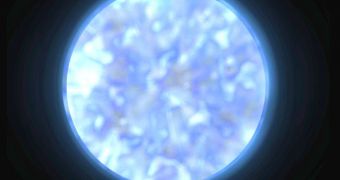The international astronomical community is trying to make sense of a peculiar star experts recently discovered some 2,000 light-years away from Earth, in the direction of the constellations Capricornus and Aquarius.
According to scientists, this particular space body features the largest amount of zirconium ever discovered in a single place in the known Universe. The star features concentrations of the stuff that are about 10,000 times higher than those on our Sun.
Additionally, the chemical is found in a particular form that has never been seen in space at all before. Chemical analyses of the star's composition also indicates that large amounts of elements such as strontium, germanium and yttrium are also present.
Estimates show that the layer of zirconium surrounding the star LS IV-14 116 weighs about 4 billion tons, several thousand times the annual production level of the stuff here on Earth.
“The huge excess of zirconium was a complete surprise. We had no reason to think this star was more peculiar than any other faint blue star discovered so far,” says in a statement Naslim Neelamkodan.
The expert was the lead author of the study, which is detailed in the latest issue of the esteemed journal Monthly Notices of the Royal Astronomical Society. He is based at the Armagh Observatory, in Northern Ireland.
The team that conducted the research explains that the celestial body is a member of a star class called helium-rich hot subdwarfs.
Studies were conducted from the Siding Spring Observatory, in New South Wales, Australia, using the Anglo-Australian Telescope there, Space reports.
The spectral signatures in the light emitted by the star showed that common elements exist on the body in the usual amounts. However, some of them are present in very high concentrations.
Such was the case with the peculiar form of zirconium the team discovered. This particular type of the chemical is only known to exist in environments heated beyond 36,000 degrees Fahrenheit (20,000 degrees Celsius).
According to the team, it could be that the highest concentrations of unusual chemicals can be found almost exclusively in the star's atmosphere. On LS IV-14 116, these clouds are the only features that can be imaged directly.
At this point, the star may be in fact in the midst of a cooling process, which characterizes the passing from a bright cool giant phase to that of a faint hot subdwarf.
Generally, when this happens, chemicals tend to either sink to the star's core, or float up to its atmosphere, which is why we are seeing these peculiar clouds in LS IV-14 116's atmosphere.
“It was very exciting to discover these completely new chemical signatures in our data,” explains Armagh Observatory expert and study coauthor Simon Jeffery.
“The peculiar abundances measured in this star, and hopefully in others, offer a new tool to explore a stage of stellar evolution, which is extremely difficult to observe directly,” he concludes.

 14 DAY TRIAL //
14 DAY TRIAL //